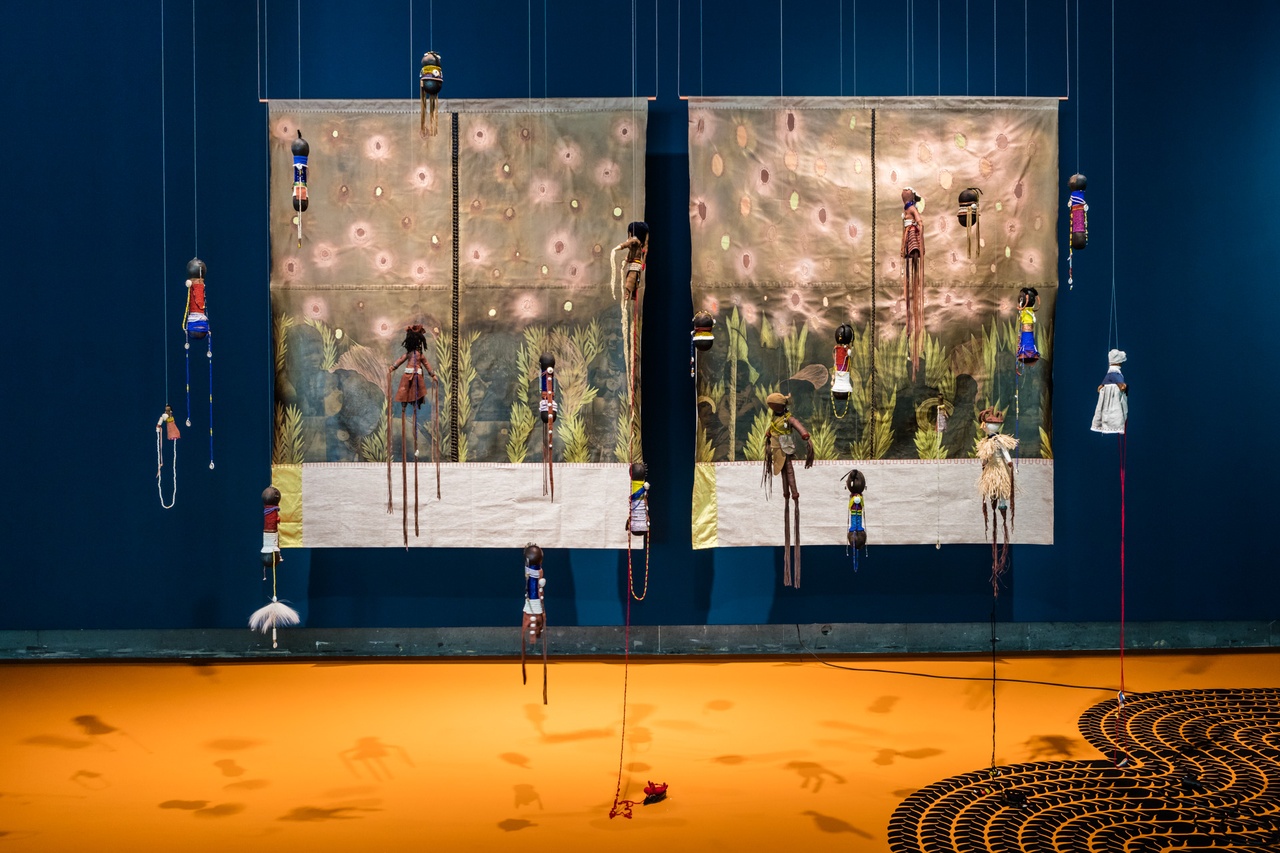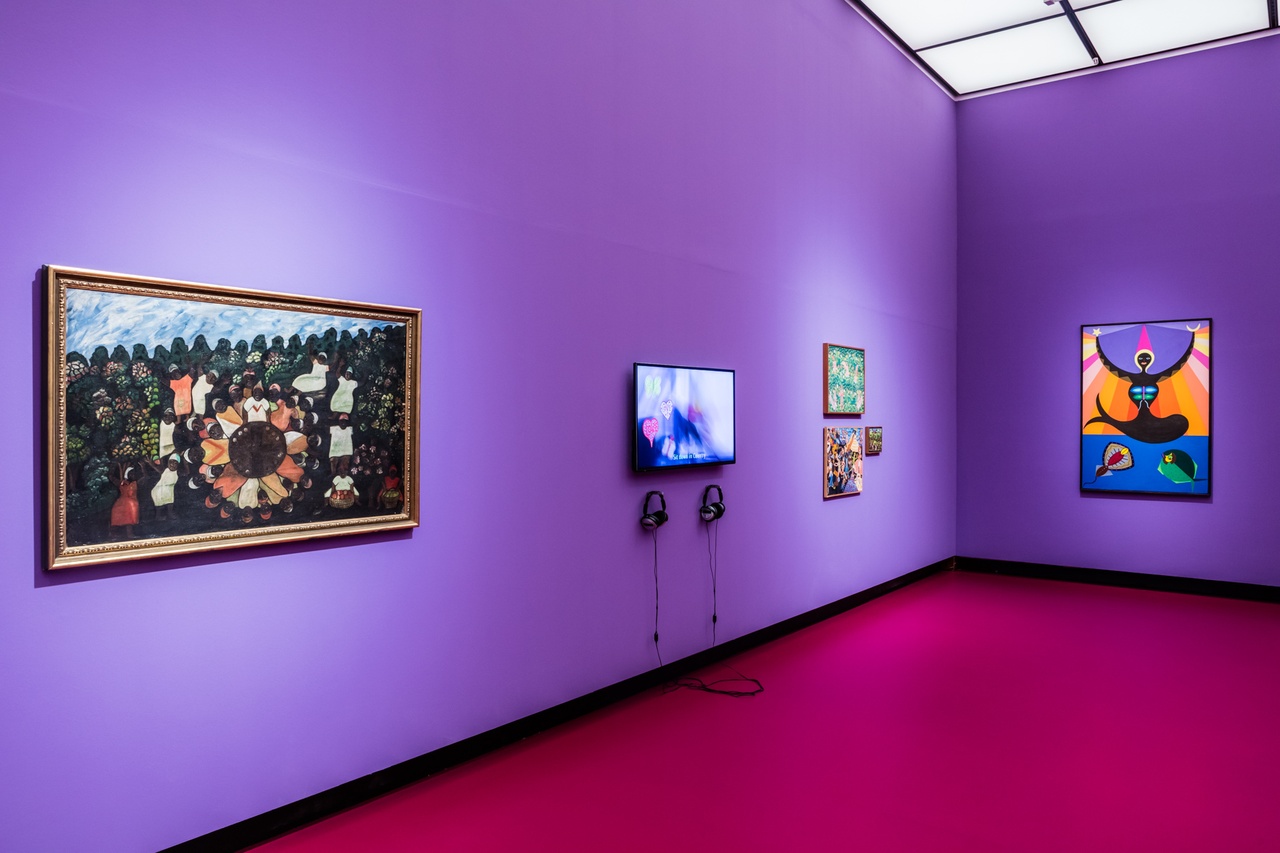Institutions are not easy to change, but it’s worth trying. Ever since HKW, one of Berlin’s government-funded institutional flagships, announced its fundamental reorientation under the new leadership of Bonaventure Soh Bejeng Ndikung, hopes are high that a long-needed increase in global perspectives will finally bring about sustainable transformation toward a more inclusive cultural landscape. To round off the series of online contributions that continue the theme of our September issue, “Reviews,” we asked three authors to share their observations of one of the most important cultural policy developments that Berlin has seen in 2023. Visiting Ndikung’s inaugural exhibition, “O Quilombismo,” Luce deLire is reminded of the various communities of gender nonconforming people that have existed throughout history and that negotiated belonging through rites of initiation instead of procreation, lineage, tradition, and bloodline. While she sees a conceptual link between the historical quilombos and trans as well as gender nonconforming people, this connection is disregarded in the exhibition. Pursuant to our current issue on “Reviews,” deLire also compares the genealogy of the exhibition with the genre of the review, as well as the body of the text with her body as a reviewer: She assesses that there is nothing natural about ancestral lineages, about a beginning, or about the smooth surface of an essay.
What is the role of the body – and whose body – in curating and in writing about art? Is it necessary to begin with my own standpoint, identity, perspective, and their embodiment? In conversation with the editors of TZK it occurred that, if written as I had wanted to write it, my piece might not be understood as a friendly contribution. Yet something inside of me resists: Why show my status ID before demonstrating what I think is worthwhile to share? In a way, negotiating this problem has become the topic of my essay…
“O Quilombismo” is the first exhibition at Haus der Kulturen der Welt realized under the leadership of Bonaventure Soh Bejeng Ndikung, who took over as director in early 2023 envisioning a “new era at HKW.” Drawing on Abdias Nascimento, it understands quilombismo as “communities created by escaped and emancipated enslaved people – as societies of ‘fraternal and free reunion.’” (my emphasis) The topic is well chosen. Given that we are living under an immensely racist inflection of capitalism that is set on course to make planet Earth uninhabitable for humans, the quilombo forms a valuable counterpoint to some of the most vile tenets of Western societies. It envisions a voluntary union where “[w]ork is not defined as a form of punishment, oppression or exploitation [… but as] a form of human liberation, which the citizen enjoys as a right and a social obligation.” And if there is anything art can do in the 21st century, it is to provide resources to imagine futures beyond global catastrophe.
I did not enter HKW with any particular expectations. Yet at some point, much too late, I started thinking of the various communities of gender nonconforming people that have existed throughout history. Hijra communities in India are among the most famous of them, but there are many more. It is not uncommon for such communities to be composed of fugitives of patriarchal incarceration, running from gendered discipline. Gender fugitives building a counter-carceral community – close enough to explore its conceptual connections to quilombismo … or so one might think.
But there is no such exploration. In the course of many redesignations initiated by Ndikung, one of the outside spaces at HKW was renamed the Lili Elbe Garden, commemorating a Danish trans painter who died in 1931. One might expect to find some reference to something trans or gender diverse here. That is, however, not the case. Another candidate might be the Markus Hirschfeld Bar, named after the German Jewish founder of the Institut für Sexualwissenschaft in Berlin, which was an early hotspot for LGBT rights activism and location of early gender-affirming surgeries, looted and dismantled by Nazis in 1933. However, at the Markus Hirschfeld Bar, the stunning video dance performance VOID (2022), by Joshua Serafin in shimmering oil, displays “queer subjectivities” as “simultaneously […] a total absence and the potential to become anything.” Serafin’s queerness is not present, but absent or merely possible. Given the long history of quilombo-like communities of fugitive trans and gender nonconforming people, I wonder: Where are the actual trans voices – especially at a spot (the Hirschfeld Bar) that references a place (the Institut für Sexualwissenschaft) prominently linked to trans women such as the painters Lili Elbe, or even Toni Ebel, whose work was recently exhibited in Berlin?
Why prefer a performance of queer absence to real trans experiences? This question may look like mere idiosyncratic disappointment. Yet that is not the case. There is a trans potential that lives right at the heart of quilombismo. For cis-heterosexual societies usually understand themselves as formed through procreation and lineage, bloodline and intercourse. BABIES BABIES BABIES BABIES. Yet Beatriz Nascimento points out that in early historical quilombos of 16th-century Angola, “initiation replaced rites of passage as practised by lineage-based systems.” For some, initiation, not lineage, is key in group formation. Nascimento describes how Imbangala societies, which successfully resisted Portuguese colonizers for some time, killed their own children at birth. They consisted exclusively of initiates adopted from the youth of those conquered during pillage. According to Nascimento, the Imbangala were constitutive of quilombismo more generally. At its “origin,” then, the “lineage” of quilombismo itself fades into an-ancestrality, a refusal of heritage as biological re-creation among cis-heterosexual couples. A refusal of BABIES. That is not to say that the Imbangala were or were not queer or trans or anything that would fit a Western category. But it is to say that within quilombismo there could be space for sexual and gender diversity beyond cis-heterosexual ideas of group formation through procreation and lineage. In fact, not unlike the Imbangala, groups of trans and gender nonconforming people have long negotiated belonging through rites of initiation instead of lineage as well. Thus, according to some reports, castration served as initiation in some historical Hijra communities. And many contemporary queer and trans “communities” are and have been formed by some sort of initiation as well – codes of belonging, shared secrets, talking about difficulties they face from lineage-based peers such as parents, siblings, etc. There’s thus a conceptual link between quilombismo and communities of trans and gender nonconforming people. Yet the exhibit does not touch that link.
As pointed out, quilombos were not necessarily formed around reproductive cis heterosexuality. The problem, then, is not historical. It is, rather, curatorial. I see it in certain notions of “ancestrality,” “lineage,” “heritage,” “tradition,” etc., which seem to form the conceptual backbone of “O Quilombismo.” If uninterrogated, these notions unintentionally normalize cis gender and in turn invite an erasure of trans people. Thus, the relative absence of trans art and artists in “O Quilombismo” in spite of the large conceptual affinity between trans communities and quilombos might not be an accident. Ideologically speaking, trans women, for example, interrupt the lineage. They are women without a womb. They cannot possibly procreate (of course they can – but differently, not in line with the patriarchal idea of how women procreate). That is why trans women traditionally figure as enemies of the nation, the people, the self – both metaphorically and politically. They do not fit in with uninterrogated notions of “ancestrality,” “lineage,” “heritage,” “tradition,” etc. For each of these terms summons versions of biological connectedness (often metaphorically) through some sense of procreation. If not openly contested, cis-coded semantic sediments sneak into the best intentions. For procreation is, more often than not, imagined to be cis gendered (BABIES!). And often, unintentionally, the longing for such cis-coded uninterrupted connection aka procreation manifests in the erasure of trans women in particular.
To take just one example (of many) from “O Quilombismo”: Tuli Mekondjo presents a set of meticulously crafted “fertility dolls, which were formerly passed down from generation to generation to practise motherhood and connect to fertility in her community, the Aawambo people.” The dolls pick up on similar dolls used in ritual practices interrupted by colonial violence. The aim of the work is “to heal and honour the interrupted ancestral lineages,” a “restitution as the restoration of ancestral fertility channels” aimed at a healing that reestablishes an originary bond. When I looked at the piece, I kept wondering: Why does this piece feel so strange? It took me a while to figure it out (speaking as if I had succeeded …). In Mekondjo’s Ounona vedu (Children of the soil), the bond between generations occurs between mother and child, visually captured by a red thread, an umbilical cord invoking blood relation, connecting two bodies, at least one of which is pretty clearly imagined to be cis-female. Such paradigmatic ancestrality and community as uninterrupted connection between mother and child is inherently cis-centric. The womb makes the woman. Trans girls are out. This is where I had meant to start this essay. Maybe putting it in the middle fits my point: There is nothing natural about ancestral lineages, about a beginning, about restoration or about the smooth surface of an essay (on which, more below). Instead, they are results of more or less violent interventions, skillful engineering, initiation. Mekondjo’s work attests to this: In order to produce the lineage from mother to mother, Mekondjo must artfully, skillfully, artificially reconnect a lineage interrupted by colonial violence. She must reimagine, revise, reinvent a ritualistic practice, must reconstruct the dolls. There is nothing “originary” here. There’s (colonial) violence and an (artistic) response. Mekondjo’s work demonstrates, possibly unintentionally, that the past is always a reconstruction, gravitating around a fragile contested present. We’ve all been dolls all along. And sometimes it takes a doll to say it.
A straightforward genealogy can only be produced artificially. This counts for intergenerational lineages (as just indicated). It also counts for my own text. I already indicated that apparently my standpoint, my body, has to back up my discursive existence. For otherwise, my intervention runs the risk of being read as the self-interested appropriation of someone else’s struggle. My body grounds the lineage, the umbilical chord between me, my text, and beyond – to you, etc. Yet this ancestry, this rhetoric of lineage does not come naturally. Both my body and my text are products of technologies: First, wherever I talk about myself in this text, I react to discursive requirements and expected suspicions. My text is deeply marked by its political context. Its structure is a technology of readability. Secondly, bodies are produced in and through devices – think of combine harvesters (food), dating apps (reproduction), and heaters (shelter). Gender-affirming medical procedures and life-saving medication are merely additional points on that spectrum. So is textuality: In this text, I am writing myself as much as my body serves to back up the text. None can serve as the secure ground of the other. Bodies cannot back up textual credibility.
And yet bodies cannot, of course, be ignored either. After all, my social existence is an important factor in my own way of experiencing reality. This is the catastrophe of critical writing that the title of this essay alludes to: The relationship between my body and my text remains inherently indeterminate. Hence, encouraged by the TZK editors, this text makes an additional point: We can stage the catastrophe instead of retroactively naturalizing an insufficient solution. Another critical discourse is possible.
Along similar lines, “ancestrality” and “lineage” do not go fully uninterrogated in “O Quilombismo.” A wonderful example is Kaylene Whiskey’s short video Ngura Pukulpa – Happy Place (2021), which “offers an extensive view of Whiskey’s Country [sic], which she reigns through ancestral connections as well as her camp fabulousness.” In expressly humorous imagery, pink-haired Whiskey flies across the land. She exclaims “stay healthy!” while eating pink cake and presenting a smile that is missing teeth. Karaoke-style captions encourage us to sing along: “Her name is Kaylene!” The humor of Ngura Pukulpa lives in citation, in the display of lyrics, in drawings juxtaposed with video, etc. This embrace of representation places Ngura Pukulpa in opposition to the alleged immediacy of ancestral connection of so many other pieces. Consequentially, Whiskey is accompanied by Black and Indigenous incarnations of Wonder Woman (“you wonder hoe”), Santa Claus, Catwoman, and others, some drawn, some filmed – a set of ancestors beyond “lineage,” but all the more imaginative, appropriated, broken up, and turned around. The cast of Ngura Pukulpa echoes the Imbangala or the Hijra community of initiates and others. Kaylene rules the land through ancestral connection, whatever that means in this context – maybe. Or maybe it’s all made up, laughing in the face of violence. In any case, Whiskey cheerfully works through problems of interrupted, fabricated, and para-national communities, thus making space for queer and trans kinship without pushing Western notions of identity.
There is an echo running between Whiskey’s Happy Place, real queer and trans communities, and the Imbangala community of initiates: interruption (not connection), technology (the medium, not immediacy), and violence (not health) are “originary” – but only in an improper sense. In fact, the improper, interruption, technology, violence are all there is. Inversely, however, the idea of healing runs the risk of producing an incurable loss: the loss of a wholesome health that never existed. It gives way to an insufferable melancholia for the impossible. In the essay “On Returning Things to Their Proper Places,” Sandow Sinai formulates a set of related questions that “O Quilombismo” might have wanted to ask: “What if diasporic national consciousness was there the whole time? What if the Africa we return to was always already building itself anew? What if Africa was always a nation that was not?” Follow-up questions could be: What if transness, just as representation, was not to be included after the fact, but was constitutive of the self all along? What if initiation, interrupted lineages, and troubled collectivities – both intergenerational and interpersonal – are originary and not the other way around? HKW made important steps in renaming some of its spaces after trans people. Future programing will reportedly include and at times focus trans artists. That is good news. Yet, as I tried to demonstrate, inclusion is not enough. There are many exhibitions to come – many opportunities for a future HKW to engage these topics. I’m excited to see the results!
“O Quilombismo,” HKW, Berlin, June 2–September 17, 2023.
Other texts on this topics have been contributed by Nina Möntmann and Kathy-Ann Tan.
Luce deLire is a ship with eight sails and she lies down by the quay. As a philosopher, she publishes on the metaphysics of infinity but also on queer theory, anti-racism, postcolonialism, and political theory. For more, see getaphilosopher.com or follow @Luce_deLire on IG.
Image credit: 1. Courtesy of the artists, photos Laura Fiorio/HKW, Berlin
Notes



